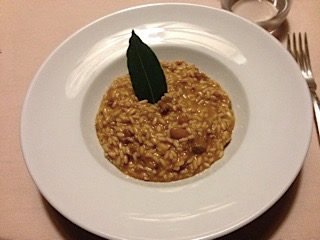Preparation time approximately 3-4 hours – Serves 10 people
Ingredients;
- 400 g Saluggia beans – see note at the bottom about Saluggia beans
- 260 g rindless bacon fat
- 1.2 kg Acquerello Carnaroli rice or arborio rice
- 2 large sausages preserved in lard, aged 4 months
- 2 onions, not big
- 6 Liebig stock cubes or use available meat stock cubes
Method:
- Soak the beans in water the night before.
- The next day put the beans with the water into a saucepan and season with 6 Liebig meat stock cubes or local available meat stock cubes.
- Add the two sausages and cook very slowly for 3 hours. When the beans are cooked, remove the sausages and drain the beans.
- Put 1/3 of the beans back into the broth.
- Chop the bacon fat, when it starts to sizzle add the two roughly chopped onions and cook for about 20 minutes, stirring and pressing with a fork until they are soft.
- Add the Acquerello carnaroli rice, stir, then add the broth and the beans together, stir again (keep a bit extra broth, just to be on the safe side in case you need to add more, NEVER ADD WATER)
- Do not stir the “Panissa” while it is cooking. When the “Panissa” is cooked, take the pan off the heat, cover it and allow to stand for about 5 minutes. If the “Panissa” is cooked properly, when you stand a spoon in the middle of the pan it should lean over by three-quarters, some of the rice will have stuck to the bottom. Many people like the rice stuck to the bottom of the pan, which the cook should serve last, upon request
Notes
- The Saluggia bean is a variety of Pheseolus vulgaris of very small dimensions grown in the municipality of Saluggia and in small portions of land in surrounding municipalities including Livorno Ferraris, Cigliano and Crescentino. The stalk of the plant reaches a maximum of 50/55 centimeters and it has a compact bush; its flowers are white and reach large dimensions. The pods are cylindrical and curved and are white/yellow with red streaks. The Saluggia bean is sown after the cultivation of barley, thus in June and July; it is harvested in September. After harvesting it is dried, since the beans are sold dry.
The beans are placed under the sun outdoors to dry when weather conditions allow this. If this is not possible a traditional dryer is used keeping the temperature low. After this phase an initial cleaning is done to separate the coarser impurities and any foreign objects like pebbles or soil.
The presence of the Saluggia bean is mentioned in some historical sources dating back to 1535 and it still plays an important role in the local economy. It was the base of the diet of people who live in the province of Vercelli; the Saluggia bean is used in some traditional dishes of the area such as fagioli in pignatta alla Saluggiese, a type of bean soup or in Panissa, a type of risotto, symbol of the cuisine of this province.
